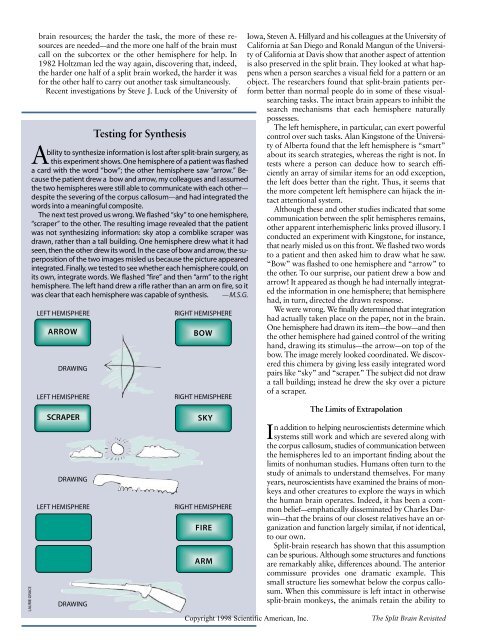The Split Brain Revisited - The University of Texas at Dallas
The Split Brain Revisited - The University of Texas at Dallas
The Split Brain Revisited - The University of Texas at Dallas
You also want an ePaper? Increase the reach of your titles
YUMPU automatically turns print PDFs into web optimized ePapers that Google loves.
LAURIE GRACE<br />
brain resources; the harder the task, the more <strong>of</strong> these resources<br />
are needed—and the more one half <strong>of</strong> the brain must<br />
call on the subcortex or the other hemisphere for help. In<br />
1982 Holtzman led the way again, discovering th<strong>at</strong>, indeed,<br />
the harder one half <strong>of</strong> a split brain worked, the harder it was<br />
for the other half to carry out another task simultaneously.<br />
Recent investig<strong>at</strong>ions by Steve J. Luck <strong>of</strong> the <strong>University</strong> <strong>of</strong><br />
Testing for Synthesis<br />
Ability to synthesize inform<strong>at</strong>ion is lost after split-brain surgery, as<br />
this experiment shows. One hemisphere <strong>of</strong> a p<strong>at</strong>ient was flashed<br />
a card with the word “bow”; the other hemisphere saw “arrow.” Because<br />
the p<strong>at</strong>ient drew a bow and arrow, my colleagues and I assumed<br />
the two hemispheres were still able to communic<strong>at</strong>e with each other—<br />
despite the severing <strong>of</strong> the corpus callosum—and had integr<strong>at</strong>ed the<br />
words into a meaningful composite.<br />
<strong>The</strong> next test proved us wrong. We flashed “sky” to one hemisphere,<br />
“scraper” to the other. <strong>The</strong> resulting image revealed th<strong>at</strong> the p<strong>at</strong>ient<br />
was not synthesizing inform<strong>at</strong>ion: sky <strong>at</strong>op a comblike scraper was<br />
drawn, r<strong>at</strong>her than a tall building. One hemisphere drew wh<strong>at</strong> it had<br />
seen, then the other drew its word. In the case <strong>of</strong> bow and arrow, the superposition<br />
<strong>of</strong> the two images misled us because the picture appeared<br />
integr<strong>at</strong>ed. Finally, we tested to see whether each hemisphere could, on<br />
its own, integr<strong>at</strong>e words. We flashed “fire” and then “arm” to the right<br />
hemisphere. <strong>The</strong> left hand drew a rifle r<strong>at</strong>her than an arm on fire, so it<br />
was clear th<strong>at</strong> each hemisphere was capable <strong>of</strong> synthesis. —M.S.G.<br />
LEFT HEMISPHERE<br />
ARROW<br />
DRAWING<br />
LEFT HEMISPHERE<br />
BOW<br />
SCRAPER SKY<br />
DRAWING<br />
LEFT HEMISPHERE<br />
DRAWING<br />
RIGHT HEMISPHERE<br />
RIGHT HEMISPHERE<br />
RIGHT HEMISPHERE<br />
FIRE<br />
ARM<br />
Iowa, Steven A. Hillyard and his colleagues <strong>at</strong> the <strong>University</strong> <strong>of</strong><br />
California <strong>at</strong> San Diego and Ronald Mangun <strong>of</strong> the <strong>University</strong><br />
<strong>of</strong> California <strong>at</strong> Davis show th<strong>at</strong> another aspect <strong>of</strong> <strong>at</strong>tention<br />
is also preserved in the split brain. <strong>The</strong>y looked <strong>at</strong> wh<strong>at</strong> happens<br />
when a person searches a visual field for a p<strong>at</strong>tern or an<br />
object. <strong>The</strong> researchers found th<strong>at</strong> split-brain p<strong>at</strong>ients perform<br />
better than normal people do in some <strong>of</strong> these visualsearching<br />
tasks. <strong>The</strong> intact brain appears to inhibit the<br />
search mechanisms th<strong>at</strong> each hemisphere n<strong>at</strong>urally<br />
possesses.<br />
<strong>The</strong> left hemisphere, in particular, can exert powerful<br />
control over such tasks. Alan Kingstone <strong>of</strong> the Universi-<br />
Copyright 1998 Scientific American, Inc.<br />
ty <strong>of</strong> Alberta found th<strong>at</strong> the left hemisphere is “smart”<br />
about its search str<strong>at</strong>egies, whereas the right is not. In<br />
tests where a person can deduce how to search efficiently<br />
an array <strong>of</strong> similar items for an odd exception,<br />
the left does better than the right. Thus, it seems th<strong>at</strong><br />
the more competent left hemisphere can hijack the intact<br />
<strong>at</strong>tentional system.<br />
Although these and other studies indic<strong>at</strong>ed th<strong>at</strong> some<br />
communic<strong>at</strong>ion between the split hemispheres remains,<br />
other apparent interhemispheric links proved illusory. I<br />
conducted an experiment with Kingstone, for instance,<br />
th<strong>at</strong> nearly misled us on this front. We flashed two words<br />
to a p<strong>at</strong>ient and then asked him to draw wh<strong>at</strong> he saw.<br />
“Bow” was flashed to one hemisphere and “arrow” to<br />
the other. To our surprise, our p<strong>at</strong>ient drew a bow and<br />
arrow! It appeared as though he had internally integr<strong>at</strong>ed<br />
the inform<strong>at</strong>ion in one hemisphere; th<strong>at</strong> hemisphere<br />
had, in turn, directed the drawn response.<br />
We were wrong. We finally determined th<strong>at</strong> integr<strong>at</strong>ion<br />
had actually taken place on the paper, not in the brain.<br />
One hemisphere had drawn its item—the bow—and then<br />
the other hemisphere had gained control <strong>of</strong> the writing<br />
hand, drawing its stimulus—the arrow—on top <strong>of</strong> the<br />
bow. <strong>The</strong> image merely looked coordin<strong>at</strong>ed. We discovered<br />
this chimera by giving less easily integr<strong>at</strong>ed word<br />
pairs like “sky” and “scraper.” <strong>The</strong> subject did not draw<br />
a tall building; instead he drew the sky over a picture<br />
<strong>of</strong> a scraper.<br />
<strong>The</strong> Limits <strong>of</strong> Extrapol<strong>at</strong>ion<br />
In addition to helping neuroscientists determine which<br />
systems still work and which are severed along with<br />
the corpus callosum, studies <strong>of</strong> communic<strong>at</strong>ion between<br />
the hemispheres led to an important finding about the<br />
limits <strong>of</strong> nonhuman studies. Humans <strong>of</strong>ten turn to the<br />
study <strong>of</strong> animals to understand themselves. For many<br />
years, neuroscientists have examined the brains <strong>of</strong> monkeys<br />
and other cre<strong>at</strong>ures to explore the ways in which<br />
the human brain oper<strong>at</strong>es. Indeed, it has been a common<br />
belief—emph<strong>at</strong>ically dissemin<strong>at</strong>ed by Charles Darwin—th<strong>at</strong><br />
the brains <strong>of</strong> our closest rel<strong>at</strong>ives have an organiz<strong>at</strong>ion<br />
and function largely similar, if not identical,<br />
to our own.<br />
<strong>Split</strong>-brain research has shown th<strong>at</strong> this assumption<br />
can be spurious. Although some structures and functions<br />
are remarkably alike, differences abound. <strong>The</strong> anterior<br />
commissure provides one dram<strong>at</strong>ic example. This<br />
small structure lies somewh<strong>at</strong> below the corpus callosum.<br />
When this commissure is left intact in otherwise<br />
split-brain monkeys, the animals retain the ability to<br />
<strong>The</strong> <strong>Split</strong> <strong>Brain</strong> <strong>Revisited</strong>

















